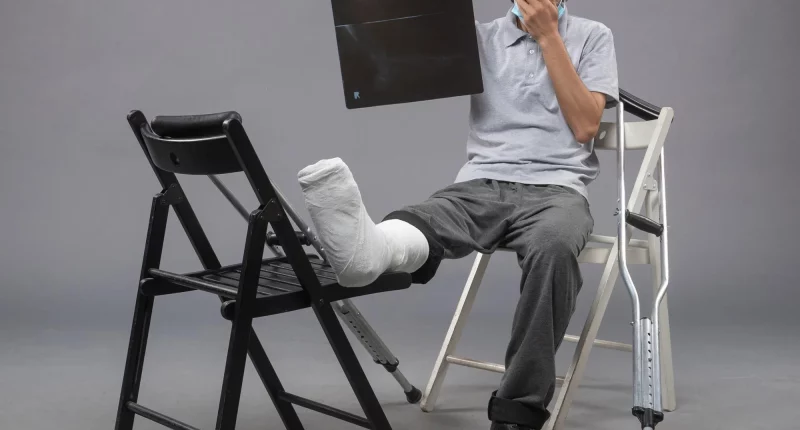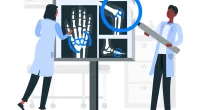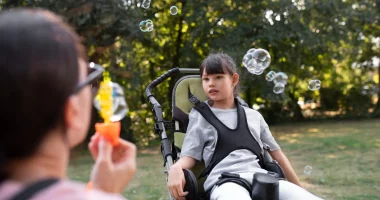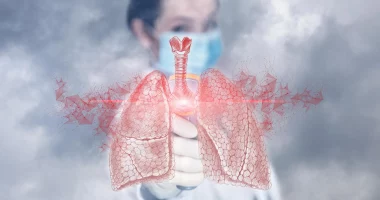A bone fracture happens when a bone cracks or breaks. It often occurs because of a strong impact or pressure on the bone. Sometimes, even a minor force can cause a fracture in people with conditions like bone cancer or osteoporosis.
When a fracture happens due to a medical condition that makes bones weaker, it is known as a pathological fracture.
What is Bone fracture?
A fracture to a bone happens when a bone either partly or completely breaks. This can happen to any bone in your body.
Fractures can occur in different ways. A closed fracture is when a bone breaks but doesn’t harm the nearby tissue or pierce into the skin.
On the other hand, a compound fracture is more severe. It not only breaks the bone but also damages the nearby tissue and breaks through the skin. These factures are riskier because they can lead to infections.
Symptoms
Symptoms of a bone fracture can vary widely depending on where it occurs, an individual’s age, overall health, and how serious the injury is. Typically, someone with a fracture will feel pain, and inflammation, and see bruising around the injured area. The skin might appear discolored, and the affected area could look unusual or stick out at an odd angle. It’s common to find it difficult or even impossible to put weight on the injured part or move it normally. Sometimes, there may be a grating feeling in the joint or bone, especially when trying to move it. If the fracture is open (where the bone breaks through the skin), there might also be bleeding.
In more serious cases, additional symptoms may occur. These can include feelings of faintness, light-headedness, dizziness, and sometimes nausea. These symptoms can be particularly concerning and might indicate complications or shock, which requires immediate medical attention to prevent further problems. Understanding these symptoms can help in recognizing when prompt medical care is necessary to ensure proper treatment and recovery from a bone fracture.
Causes
Bones are strong and can handle a lot, but they can break if they’re hit hard enough. The main reasons bones break are accidents, repetitive stress, and conditions that make bones weaker, like osteoporosis. Other things can also make someone more likely to break a bone.
As people get older, their bones naturally get weaker, which makes them more likely to break. Aging also raises the chances of increasing conditions that weaken bones.
Diagnosis and Treatment
When someone breaks a bone, a healthcare provider will first ask about how it happened and then do a physical exam to figure out what’s wrong.
Most of the time, the healthcare provider will ask for an X-ray to see the fracture clearly. Sometimes, they might also need a CT or MRI scan for a better look.
Bones can heal on their own, so treatment focuses on helping the bone heal well and work properly in the future. To start the healing process, the healthcare provider will put the broken pieces of bone back in place. For smaller fractures, this can be done by gently moving the bone from the outside. But for more serious breaks, surgery might be needed.
Once the bones are lined up, the doctor will keep them in place using different methods like casts, metal plates, screws, rods inside the bone, or external devices. Healing can take weeks to months, depending on how bad the break is and if there are any problems like not enough blood flow or infection.
Factors like cigarette smoking, drinking a lot of alcohol, being overweight, taking certain medicines, and age can affect how well bones heal. Once the bone is healed, physical therapy might be needed to make the muscles strong and help move the injured part better.
If a fracture happens near a joint, there’s a risk that the joint might get stiff or have arthritis later on. This could mean the joint won’t move as well as it did prior to the injury.
Complications
Complications can sometimes arise during the healing process of bone fractures, despite appropriate treatment. One common issue is when a fracture heals in the incorrect position or if the bones move while they are healing. This can affect how well the bone functions once healed. In childhood fractures, disruptions during healing may alter the bone’s normal growth, potentially leading to future deformities.
Another complication is infection, particularly in compound fractures where bacteria can enter through the broken skin and infect the bone marrow or bone. Such infections can be persistent and challenging to treat. Additionally, if a bone loses its blood supply, a condition known as avascular necrosis may occur, causing the bone tissue to die.
Non-unions and delayed unions are also concerns. Non-unions are fractures that do not heal properly, while delayed unions take longer than expected to heal. Treatments for these conditions can include ultrasound therapy to stimulate healing, bone grafting to replace damaged bone tissue or stem cell therapies that aim to promote bone regeneration. These interventions are used to encourage proper healing and reduce the risk of long-term complications associated with unresolved fractures.
Prevention
There are several ways to lower the chances of getting a bone fracture through lifestyle changes and treatments.
Eating foods rich in calcium, like milk, yogurt, cheese, and green leafy vegetables, helps keep bones strong. Vitamin D is also important because it helps the body take calcium. Getting sunlight and eating foods like oily fish and eggs are good ways to get enough vitamin D.
Doing weight-bearing exercises, like jogging or walking, can build muscle and make bones stronger. This lowers the risk of fractures. For individuals with osteoporosis, studies have shown that regular exercise and a balanced diet can help prevent fractures.
During and after menopause, estrogen levels drop, which can affect bone health. This makes it harder to regulate calcium and increases the chance of fractures and osteoporosis. It’s important for people, especially women going through menopause, to take care of their bone strength and density.
Summary
Bone fractures can result from accidents, weakening bones, or overuse. Symptoms include pain, swelling, and difficulty moving the injured area. Diagnosis involves X-rays and treatment often includes realigning bones and using casts or surgery.
Complications like infections or delayed healing can occur. Prevention focuses on calcium-rich diets, vitamin D, exercise, and managing bone health during and after menopause. Early treatment and lifestyle changes can reduce fracture risks and promote faster healing.









